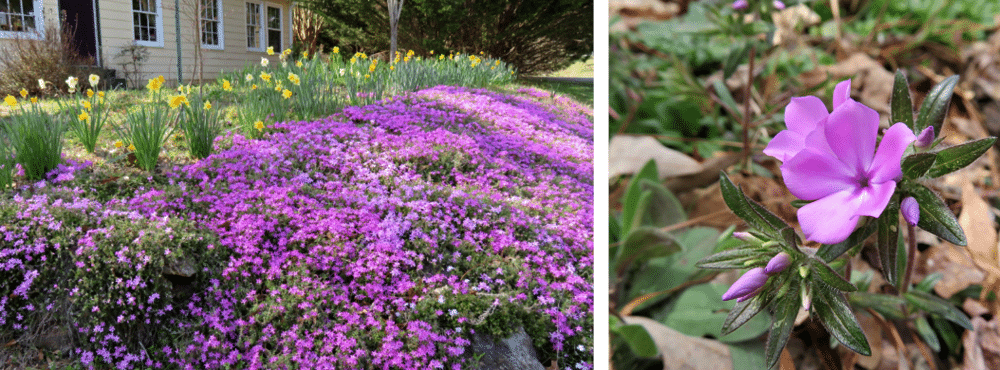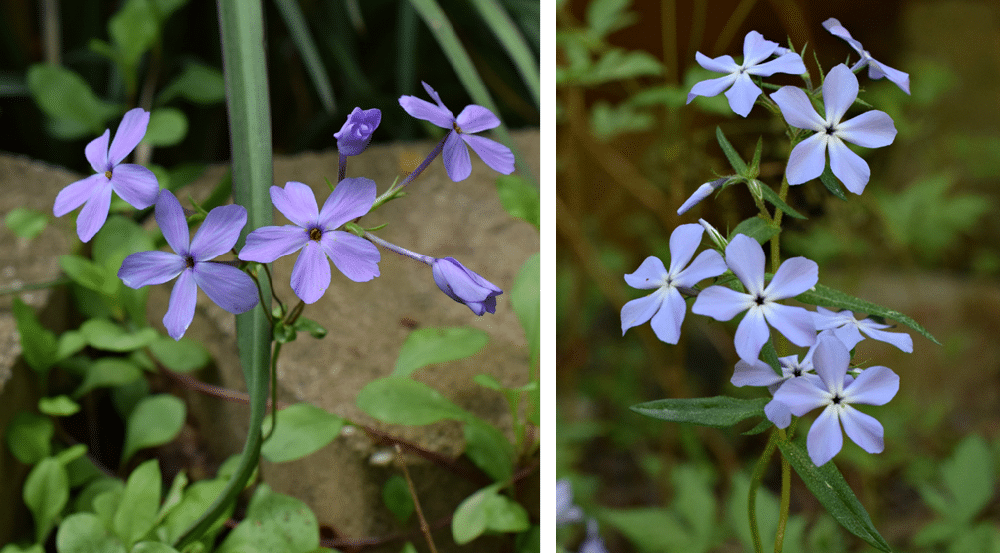Left: Moss phlox (Phlox subulata), spreading over a slope. Right: Sun-loving hairy phlox (Phlox amoena).
Phlox is an almost uniquely North American plant, with 61 species in all, and Georgia has a respectable selection of spring and summer-blooming species throughout the state. This month we’ll talk about the spring species, and perhaps no single one is more well-known than moss phlox, Phlox subulata. This species is found in many landscapes, both old and new, where it bursts into a carpet of pink in March (for some strange reason, a local common name for it is ‘thrift’). Its low-growing evergreen leaves are almost unnoticed the rest of the year. Trailing phlox, Phlox nivalis, closely resembles it but the vast majority is marketed as Phlox subulata. Both are sold in hues of pink ranging from almost white to deep pink. Nurserymen are also breeding other color forms now. Both of these species grow best in full sun. A cemetery near me has lots of Phlox nivalis growing among the headstones and the color variations are delightful.
Shadier landscapes are perfect for the two blue woodland phlox species: Phlox divaricata (woodland phlox) and Phlox stolonifera (creeping phlox). As you might expect from the name, P. stolonifera spreads to form a nice groundcover, with short flowering stalks held above the plant. Woodland phlox is more clump-forming and is a taller plant than creeping phlox. I love to see Phlox divaricata blooming in Cloudland Canyon State Park in April. Once I saw an early butterfly flitting from flower to flower.
The tallest of the spring phlox is smooth phlox (Phlox glaberrima). It grows up to 3 feet in part sun, creating a handsome plant in the May garden. It often has deep pink flowers. While I haven’t seen it sold much in the past, this species seems to be getting more attention lately by propagators so hopefully we will see it sold more often.
The last two spring phlox species are sun-loving ones. Hairy phlox (Phlox amoena) and downy phlox (Phlox pilosa) are both fairly short and have deep pink flowers. Both have fine hairs on the stems and leaves, and both are fairly well-distributed in the state. Whichever one you get, they are both superb garden plants as are all the species discussed here.
So, if you don’t have any spring phlox in your landscape, now is the perfect time to hit the spring plant sales and find some. Nearly Native Nursery is an excellent place to check for it year-round while Chattahoochee Nature Center has been growing it for spring sales. A good reference book for phlox is “Phlox: A Natural History and Gardener’s Guide by James Locklear (2011).”
Two blue phlox species. Left: Phlox stolonifera (creeping phlox). Right: Phlox divaricata (woodland phlox)


